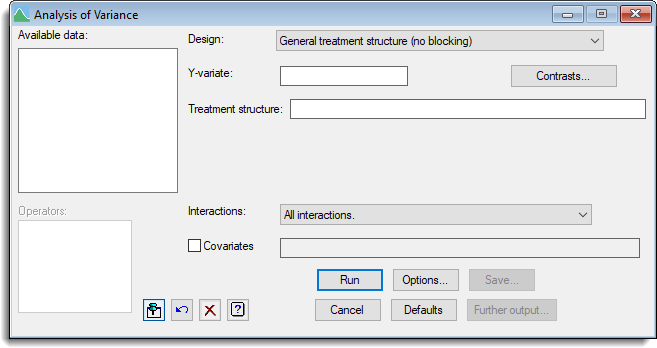Select menu: Stats | Analysis of Variance | General
The General Treatment Structure (no Blocking) menu lets you fit completely general treatment models to data from designs where there is no blocking of any sort.
- After you have imported your data, from the menu select
Stats | Analysis of Variance | General. - From the Design dropdown list select General treatment structure (no blocking).
- Fill in the fields as required then click Run.
You can set additional Options then after running, you can save the results by clicking Save.

Available data
This lists data structures appropriate to the current input field. It lists either factors for use in specifying the treatment structure, or variates for specifying the data and additional covariates. The contents will change as you move from one field to the next. Double-click a name to copy it to the current input field or type the name.
Design
Select the type of design.
Y-variate
Set this to the variate containing the data values.
Treatment structure
Specify the treatment terms to be fitted by entering a model formula.
Contrasts
Opens a menu that lets you specify one or more treatment contrasts that you wish to analyse.
Interactions
Controls the level of interactions to be fitted. You can specify All interactions, No interactions, (i.e. main effects.), or specify the level of interaction (that is, set a limit on the maximum number of factors in the treatment terms that are fitted).
Operators
This provides a quick way of entering operators in the treatment model formula. Double-click the required symbol to copy it to the current input field. You can also type in enter operators directly. See model formula for a description of each.
Covariates
Select the check box if you want to perform analysis of covariance. The adjacent field will become enabled to let you supply a list of the covariates for the analysis. If there is more than one, you must separate their names with spaces or commas.
See also
- General Treatment Structure (in Randomized Blocks)
- General Analysis of Variance
- Options for choosing which results to display
- Contrasts menu, for specifying contrasts
- Further Output for additional output subsequent to analysis
- Saving Results for further analysis
- Residual Plots and Means Plots for graphical output
- ANOVA Equivalence Test